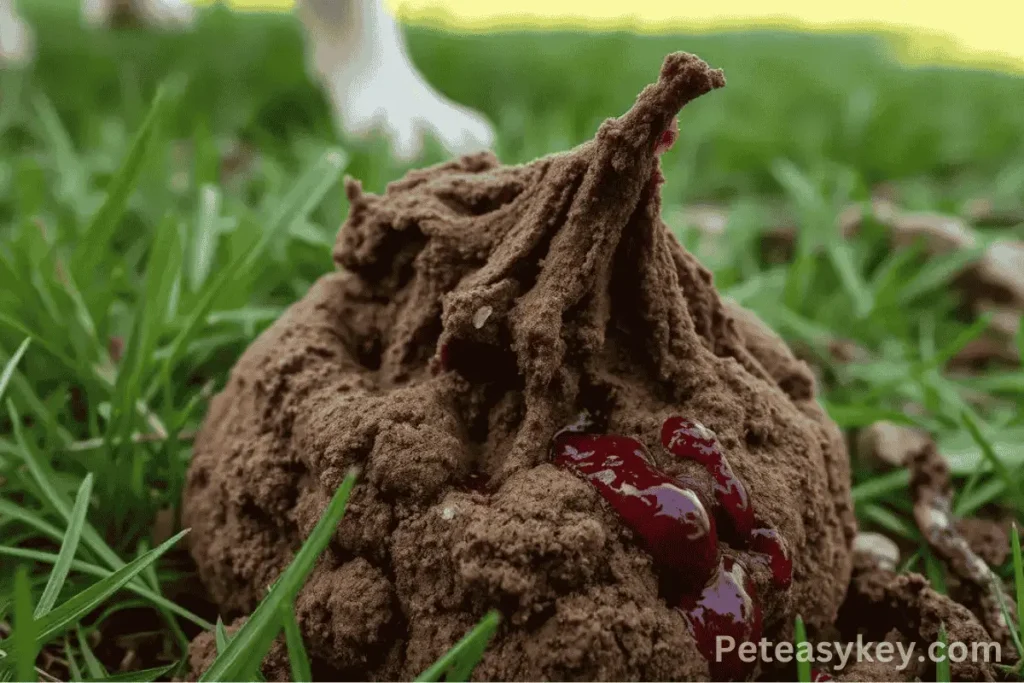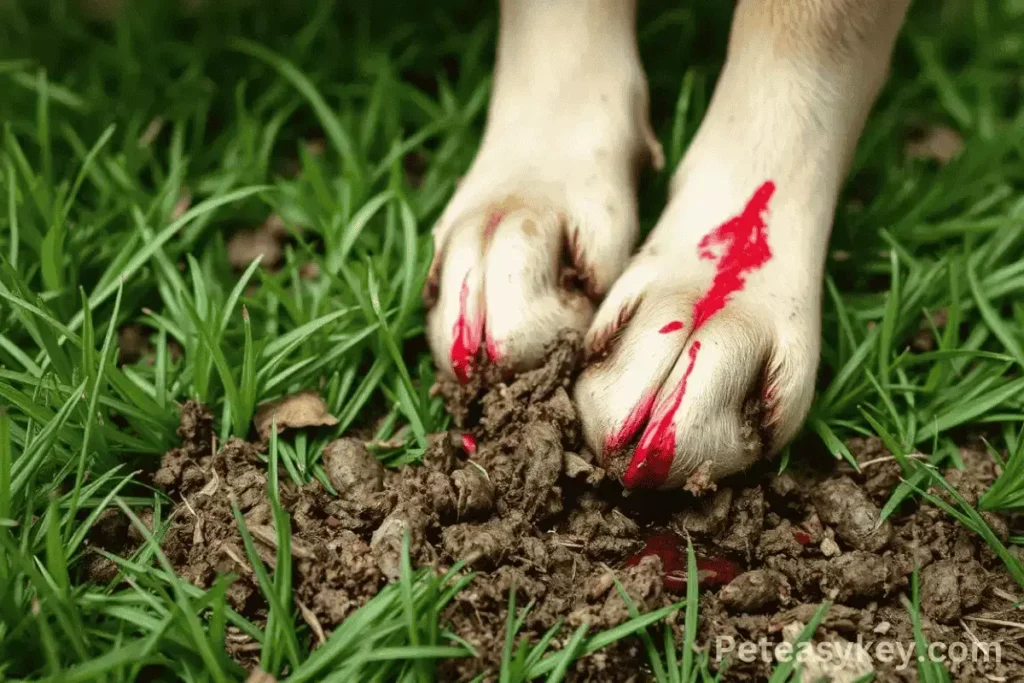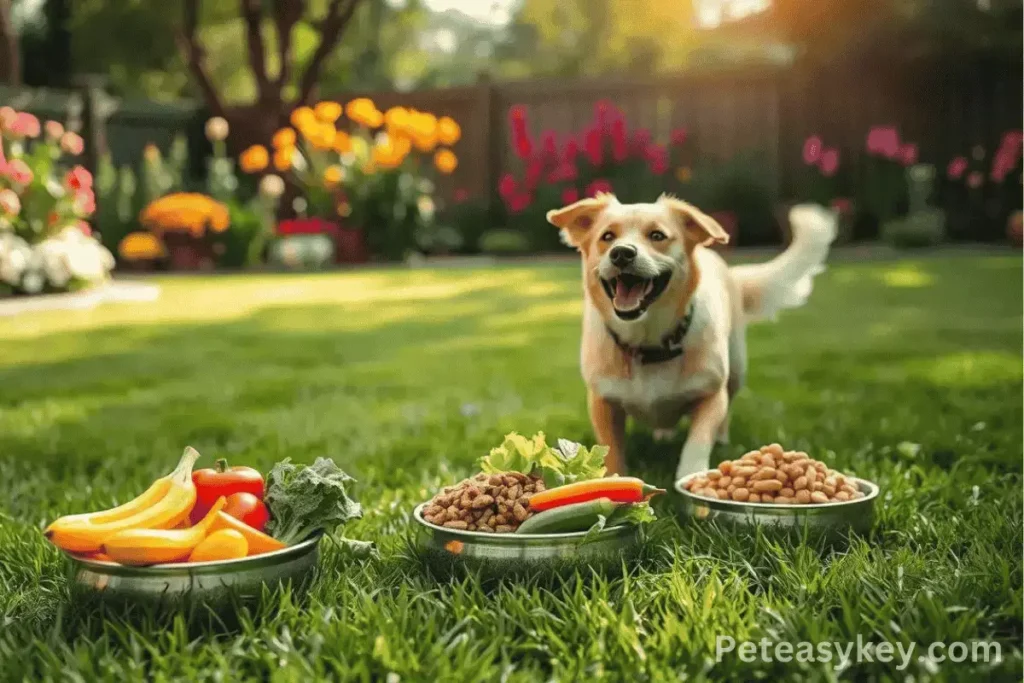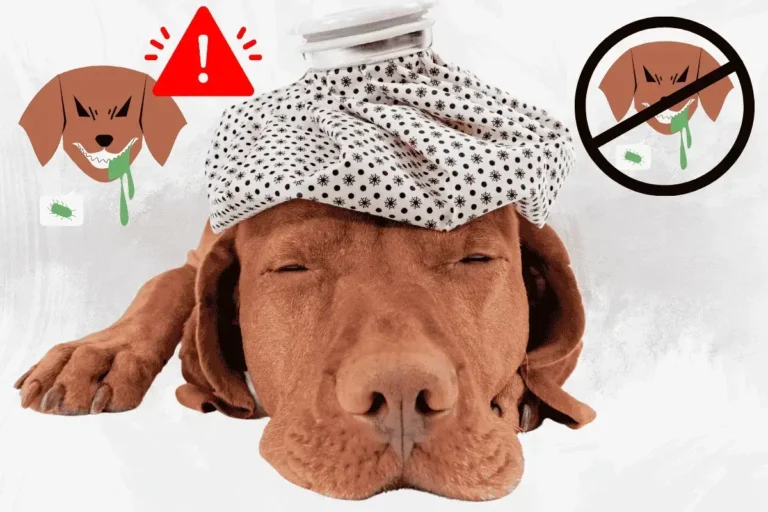why is there blood in my dogs poop? Understanding Causes and What to Do
why is there blood in my dogs poop? Seeing blood in your dog’s stool can be scary. But, it’s a common sign that needs quick action. Blood in a dog’s poop can mean many things, from minor issues to serious health problems. It’s essential to watch your dog’s poop closely. Changes in color, consistency, or frequency can show health issues early.
So, what causes blood in a dog’s stool, and what should you do? Let’s look into the different types of bloody stools, their causes, and how to keep your dog healthy.

Key Takeaways
- Blood in a dog’s stool can be a concerning symptom that requires prompt attention.
- Bloody stools can appear as bright red streaks (hematochezia) or dark, tarry stools (melena), indicating different areas of bleeding within the digestive tract.
- Common causes include dietary indiscretion, internal parasites, gastrointestinal Inflammation, and even cancer or tumors.
- Immediate vet care is necessary if your dog is vomiting or showing other signs of distress, such as lethargy or weakness.
- Diagnostic tests and treatments will vary depending on the underlying cause, so it’s crucial to work closely with your veterinarian.
Understanding Different Types of Bloody Stool in Dogs
If your dog has pooped blood, it’s essential to know the types and their causes. The blood’s color and look can help your vet find the problem.
Hematochezia: Bright Red Blood
Hematochezia means bright red blood in dog stool. It shows the bleeding is from the lower gut, like the colon or rectum. This blood often comes with diarrhea and might look like streaks on the stool’s edge.
Melena: Dark and Tarry Blood
Melena is dark, tarry blood in dog stool. It means the bleeding is from the upper gut, like the stomach or small intestine. The blood looks dark because it’s been partially digested.
Pure Blood in Dog Stool
Sometimes, your dog might pass pure blood. This happens when there’s a liquid stool or an empty gut. Blood coming out alone is a serious sign that needs vet help right away.
Knowing the blood’s color and look helps your vet find where the bleeding is. It’s critical to get your dog to the vet fast if they poop blood.
Common Causes of Blood in Dog’s Stool
If your dog is pooping blood, it’s alarming. But there’s no need to panic. There are many reasons why this might happen. Knowing the cause can help you take the proper steps to help your dog feel better.
Bright red blood in dog stool usually means a problem in the lower digestive tract. This could be due to inflammatory bowel disease, colitis, infections, or even tumors. On the other hand, dark, tarry stools suggest issues higher up, like ulcers or severe infections.
Foreign objects, liver or kidney disease, and certain medications can also cause bloody stools. Parasites like hookworms or giardia can lead to internal bleeding and visible blood.
| Cause | Description |
|---|---|
| Inflammatory Bowel Disease (IBD) | Chronic inflammation in the digestive tract, leads to diarrhea and bloody stools. |
| Colitis | Inflammation of the large intestine, causes mucousy diarrhea with blood. |
| Infections | Viral, bacterial, or parasitic infections can trigger gastrointestinal bleeding. |
| Tumors or Polyps | Growths in the digestive system can lead to bleeding and bloody stools. |
| Trauma | Internal injuries to the digestive tract or rectum can cause bright red blood in dog stool. |
| Acute Hemorrhagic Diarrhea Syndrome (AHDS) | A sudden, severe condition causing bloody, watery diarrhea, vomiting, and dehydration. |
| Gastrointestinal Ulcers | Stomach or intestinal ulcers can lead to dark, tarry stools (melena). |
| Parasites | Intestinal parasites like hookworms, whipworms, and giardia can cause internal bleeding and bloody stools. |
If your dog is pooping blood, get them to the vet quickly. This is especially true if they’re vomiting, seem tired, or are losing a lot of blood. Your vet can run tests to find out why and help your dog get better.
Why is there blood in my dogs poop: Immediate Action Steps
If you see blood in dog stool, act fast. Blood could mean a severe health problem that needs quick vet care. Here’s what to do when you see this symptom.
When to Call Your Vet
Call your vet right away. Don’t wait to see if it goes away by itself. Blood in dog stool can mean many things, from bad food to severe issues. Your vet can find out why and fix it.
Emergency Warning Signs
- Lethargy or weakness
- Pale gums
- Vomiting
- Straining to defecate
- Refusing food or water
- Unresponsiveness
If your dog shows any of these signs, go to the vet fast. These could mean a serious problem that needs quick help.
At-Home Care Options
Small amounts of bright red blood might be from bad food or a minor irritation. If it’s just a little and your dog seems fine, try a few things at home. Make sure they drink water and save a poop sample for the vet. But if it gets worse or doesn’t get better, call your vet right away.
It’s essential to deal with blood in dog stool quickly. By acting fast and getting vet advice, you can find and fix the problem. This keeps your dog healthy and happy.
Diagnostic Procedures and Tests
If your dog has bloody stools, your vet will do several tests to find the cause. These tests help figure out the problem and how to treat it. They might include physical exams, lab tests, and imaging studies.
Your veterinary will first do a physical exam. They’ll check your dog’s belly and look for any signs of pain or issues. They might also do a rectal exam to check the lower part of the gut. These steps give clues about where the bleeding might be coming from.
- SStool analysis: Your vet will look at your dog’s stool under a microscope. They’ll check for parasites, bacteria, or other problems that could cause the bleeding.
- Blood tests: A complete blood count (CBC) and chemistry panel can show if there’s anemia, infection, or clotting issues. These can cause bleeding.
- Imaging tests: X-rays or ultrasounds might show problems like tumors, foreign objects, or blockages in the gut. These could be causing the bleeding.
- Endoscopy or colonoscopy: Sometimes, your vet might suggest a more detailed test. This lets them see inside the gut and take tissue samples for more checks.
Using these tests, your vet can discover why your dog is bleeding. They’ll use this info to make a treatment plan. Finding the cause early is vital to your dog’s health.

“Prompt and thorough diagnostic testing is essential when dealing with any gastrointestinal issues in dogs, especially those involving blood in dog stool,” explains Dr. Sarah Johnson, a board-certified veterinary internist. “The sooner we can identify the underlying cause, the better we can tailor the treatment to your pet’s specific needs.”
Understanding Gastrointestinal Inflammation and Bleeding
Seeing blood in dog stool is a worrying sign. It means something is wrong in their GI tract. Knowing where and why the Inflammation is happening helps your vet figure out what to do next.
Upper GI Tract Issues
Bleeding in the upper digestive tract, such as in the stomach or small intestine, can cause melena. This is when your dog’s stool looks like coffee grounds. Peptic ulcers, tumors, or blockages from foreign objects are common causes.
Lower GI Tract Problems
Hematochezia is when your dog’s stool has bright red, fresh blood. This usually means the bleeding is in the lower GI tract, like the large intestine or rectum. Conditions like colitis or parasitic infections can cause this.
Inflammatory Conditions
Recurring bloody stools might mean your dog has an inflammatory condition. Inflammatory Bowel Disease (IBD) or hemorrhagic gastroenteritis can cause a lot of inflammation and irritation. This leads to bloody diarrhea that comes and goes or doesn’t stop.
| Condition | Symptoms | Potential Causes |
|---|---|---|
| Melena | Dark, tarry stools | Upper GI tract bleeding, such as peptic ulcers or tumors |
| Hematochezia | Bright red, fresh blood in dog stool | Lower GI tract issues, including inflammatory conditions or parasitic infections |
| Inflammatory Bowel Disease (IBD) | Chronic, intermittent bloody diarrhea, weight loss, vomiting | Immune-mediated inflammation of the GI tract |
| Hemorrhagic Gastroenteritis | Acute, severe bloody diarrhea, vomiting, dehydration | Sudden, severe inflammation of the GI tract, often of unknown cause |
Knowing where and why your dog’s GI tract is bleeding helps your vet. They can then decide on the proper tests and treatment. Quick action is vital to fixing your dog’s GI health.
Treatment Options for Bloody Stools in Dogs
If your dog has bloody stools, the treatment will depend on the cause. Your vet will find the central problem and create a plan to fix it. This plan will help your dog feel better.
- Potential treatments for why is there blood in my dogs poop include:
- Dietary changes, like a bland diet, ease the intestines.
- Medicines to lessen Inflammation and pain, like anti-inflammatory drugs or corticosteroids.
- Antibiotics for bacterial infections or parasites causing the dog poop blood.
- Anti-parasitic drugs to get rid of intestinal parasites.
- Probiotics to balance the gut.
- Fluid therapy to fight dehydration and replace lost electrolytes.
In severe situations, your dog may have to remain in the hospital for added support. Surgery could be needed for issues like tumors, ulcers, or blockages in the GI tract.
| Treatment Approach | Potential Benefits |
|---|---|
| Dietary Changes | Helps soothe the intestines and promote healing |
| Medications | Reduce inflammation, pain, and treat underlying infections |
| Fluid Therapy | Addresses dehydration and replenishes electrolytes |
| Surgery | Treats physical obstructions, tumors, or other severe GI issues |
The main goal is to find and fix the cause of why is there blood in my dogs poop. Your vet will also help your dog feel better and heal. They will work with you to find the best treatment for your pet.
Recovery and Management Strategy
Getting your dog to recover from bloody stools needs a few steps. First, you should change their diet. Try a bland diet like boiled chicken and rice to help their gut heal. Slowly add back their usual food, watching for any more bleeding.
It’s essential to keep an eye on your dog’s health during recovery. Look at the color, texture, and how often they poop. A good stool quality and no more blood are good signs. Keeping a poop journal helps you and your vet see how well they’re doing.
Follow-up Care
Regular veterinary visits are crucial to your dog’s recovery. Your vet might want to do more tests or adjust meds. This helps find the cause and keeps your dog healthy.
Some dogs need special diets or probiotics for a long time. These help keep their gut healthy and prevent more bleeding. Your vet can guide you on what’s best for your dog.
Working with your vet and following their advice is crucial. With time and the proper care, most dogs can get better. They can even go back to being happy and healthy.
Prevention Tips and Long-term Care
To keep your dog’s digestive health in check, you need a few key steps. These steps can safeguard your dog and prevent future stomach problems. It’s all about keeping your dog happy and healthy.
First, make sure your dog eats the right food. Talk to your vet about the best diet for your dog. Also, don’t forget to give your dog regular medicine to fight off parasites.
- Maintain a balanced, veterinarian-approved diet for your dog
- Administer parasite prevention medication as prescribed
- Keep your dog’s vaccinations up to date to prevent infectious diseases
- Minimize your dog’s exposure to potential toxins and hazardous items
Regular vet visits are essential. Your veterinary can spot problems early and suggest treatments. They can also help with diet changes if needed.
If your dog has ongoing stomach issues, you’ll need to take extra steps. This might include special diets, medicine, and watching their health closely. Keeping your dog calm and active can also help prevent stomach problems.
“Early detection and proactive management are key to keeping your dog’s digestive system healthy and preventing recurring episodes of bloody stools.”
By following these tips and working with your vet, you can keep your dog healthy for years to come. This way, you can avoid future stomach problems and keep your dog happy.

When Blood in dog Stool Becomes Life-Threatening
Blood in your dog’s stool can be scary, but it’s not always a big deal. Yet, in some cases, it can mean a severe health issue that needs quick vet care. Knowing how serious it is helps your dog get the help they need fast.
Considerable, uncontrollable bleeding is a big worry. If your dog has a lot of bright red blood or dark stools, it might mean severe bleeding inside. Also, if they seem very tired, have trouble breathing, or their gums look pale, it’s a sign of a big problem.
Diseases like parvovirus, hemorrhagic gastroenteritis (HGE), or severe injuries can be deadly if not treated immediately. Parvovirus is especially dangerous for young, unvaccinated puppies. Quick vet care is critical to saving your dog’s life.
| Condition | Description | Risk Level |
|---|---|---|
| Parvovirus | A highly contagious viral infection that primarily affects young, unvaccinated puppies, leading to severe diarrhea, vomiting, and dehydration. | High |
| Hemorrhagic Gastroenteritis (HGE) | A condition characterized by sudden-onset, severe bloody diarrhea, often accompanied by vomiting, lethargy, and dehydration. | High |
| Internal Injuries | Traumatic injuries, such as from ingesting sharp objects or blunt force trauma, can lead to internal bleeding and life-threatening complications. | High |
If you see any of these scary signs, call your vet right away. Quick action can save your dog’s life.
“Addressing bloody stool in dogs requires swift action to determine the underlying cause and provide the necessary treatment. Waiting too long can have devastating consequences.”
Conclusion
Blood in a dog’s stool is a sign that needs immediate attention. Simple diet changes or severe health issues can cause it. Always seek vet help quickly.
Knowing the types of bloody stools, like hematochezia, helps you act fast. This way, you can tackle the problem effectively.
Getting the correct diagnosis and Therapy is critical to managing why is there blood in my dogs poop. Your vet can guide you to improve your dog’s health. Keeping your dog’s diet healthy and regular vet visits can also help prevent future issues.
Being watchful and getting professional help when needed is crucial. Many dogs can get better from bloody stools with the proper care. Remember, your dog’s health is essential. Taking quick action can make a real difference in your dog’s recovery.
FAQ
What are the different types of bloody stools in dogs?
Dogs can have three types of bloody stools. Hematochezia is bright red blood showing bleeding in the lower digestive tract. Melena is in dark, tarry stools, showing bleeding in the upper digestive tract. Pure blood without stool can happen with liquid stool or an empty gut.
What are the common causes of blood in dog stool?
Blood in a dog’s stool can come from many things. This includes eating things they shouldn’t, parasites, infections, and inflammatory bowel disease. Other causes are hemorrhagic gastroenteritis, stomach ulcers, trauma, ingesting foreign bodies, toxin exposure, and tumors.
When should I call the vet for blood in my dog’s stool?
Call your vet right away if you see blood in your dog’s stool. Look out for signs like lethargy, weakness, pale gums, vomiting, and straining to defecate. Also, watch for refusing food or water, and being unresponsive.
What diagnostic procedures will the vet use to determine the cause?
Vets use many tools to find the cause. These include physical exams, rectal exams, and stool analysis. They also do blood tests, x-rays, and sometimes endoscopy or colonoscopy. Tests might include fecal exams, giardia, and parvo tests, and pancreatic function tests.
How is the location and nature of the gastrointestinal Inflammation determined?
Upper GI issues often cause melena. Lower GI problems usually lead to hematochezia. Chronic bloody stools can result from disorders like colitis, or inflammatory bowel disease can cause chronic bloody stools. Hemorrhagic gastroenteritis is a severe condition causing acute bloody diarrhea.
What are the treatment options for bloody stools in dogs?
Treatment varies based on the cause. It might include changing their diet, using medications to soothe the intestines, or antibiotics for infections. Anti-parasitic drugs, probiotics, fluid therapy, corticosteroids, and surgery might also be needed.
How can I support my dog’s recovery from bloody stools?
Supporting recovery means changing their diet and monitoring their progress. Follow-up care is vital. Probiotics and supplements can help with gut health.
How can I prevent recurring episodes of bloody stools in my dog?
To prevent recurring bloody stools, keep their diet balanced and prevent parasites. Make sure vaccinations are up to date. Minimize toxin exposure and manage any chronic digestive conditions.
When is blood in a dog’s stool considered life-threatening?
Blood in a dog’s stool can be life-threatening if it causes severe dehydration, anemia, or shock. Look out for profuse bleeding, extreme lethargy, collapse, difficulty breathing, or pale gums. Immediate vet care is essential.





2 Comments